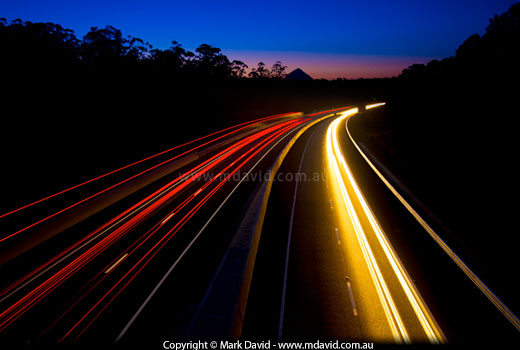
It’s easy to get nice visual effects in your long-exposure night-time photos of traffic.

Trails of lights reveal a bend in the Bruce Highway in SE Queensland.
What you need
You just need your SLR, a tripod, cable release and a place to work that’s not in the path of a whole bunch of speeding cars.
Settings
This is one of those times that just screams “B” in your mode dial. That “B” stands for “Bulb” mode. When your camera’s in bulb mode the shutter stays open for as long as you hold down the shutter button.
Focus
When you press the shutter button you don’t want your camera hunting for focus in the dark. So it’s best to focus your camera manually. In the photo above I was using a wide-angle lens, which automatically gives a big depth of field, and I focused on a point just before the horizon.
ISO
Modern cameras are so good in low light now that you can almost shoot in the dark. But to get a nice long light trail we need the exposure to run for several seconds. That means we won’t be taking advantage of the high ISO levels available in our cameras. I set my ISO to my camera’s minimum, which was 100.
Tripod
The moment you mention long exposures you have to think about a way of keeping your camera rock-steady, so I use a tripod.
Cable release

Mechanical (left) and electronic (right) cable releases. Personally I prefer the old-fashioned mechanical cable releases because they are so simple they never fail, but a lot of modern digital cameras won’t work with them these days. The modern electronic ones, are full of complicated electronics that might not last forever. And the electronic ones are not only more expensive, but each one only works on a small number of cameras because camera manufacturers keep changing the design of the port/plug in their new cameras, forcing us to buy another damn cable release each time. Your camera’s manual should tell you what kind of cable release works with your camera.
The moment you mention long exposures you usually also need to think about a cable release. What’s a cable release? It’s a cord with a button at one end and you plug the other end into a special port/hole in your camera. From then on, pressing the button at the end of the cable is like pressing the shutter button on your camera. The vibrations you create when you press the shutter button on the cable fail to travel all the way down the cord and so you avoid jiggling your camera during your long exposure, resulting in much sharper photos.
Take a test shot
If it’s dark already then try a test shot. Wait for some cars to drive into your camera’s field of view and then try something like a 5-second exposure to see if that captures sufficient lengths of light trails. In other words, you squeeze the shutter button in on your cable release when some cars drive into a good bit, and don’t let it go for 5 seconds. In my case the light trails I got weren’t long enough with 5 seconds so I did an 8-second exposure and was much happier with it. I’m not being super-precise here — I just count the seconds in my head. You don’t need to be any more accurate than that.
Cars’ tail lights and headlights are super bright so your camera should have no problems recording their trails when the cars move. With exposures lasting that long, don’t expect to see much of the cars though. Remember that the cars will be smeared across just as much of the frame as the light trails. So they will most likely be invisible.
Remember too, if you let your exposures run for really long times then not only will get very long light trails, but the rest of the scenery should start becoming visible in your shots too.








